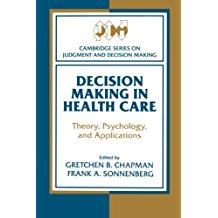 (Part of the Cambridge Series on Judgment and Decision Making)
(Part of the Cambridge Series on Judgment and Decision Making)
Editors: Gretchen B. Chapman, PhD; and Frank A. Sonnenberg, MD
Publisher: Cambridge University Press – 438 pages
Book Review by: Sonu Chandiram
Decision making in health care has become a rapidly growing field in medicine that oftentimes puts physicians, their patients, hospital CEOs and administrators, and health insurance companies at odds with one another because of competing interests. The competing parties’ interests influence their decisions, and consequently, the outcomes of their decisions. The outcomes can sometimes be beneficial for some of the parties, but disastrous for others.
Those decisions can lead to improving patients’ health and prolonging their lives, or to impairing their health, and even causing death. This book provides the necessary tools to all concerned parties to make the best decisions.
Twenty-seven specialists, mainly in psychology, but also in areas such as clinical health policy, health care policy, the health sciences, therapeutics research, and veterans’ affairs, working at various universities and other information-gathering places around the United States, authored the 15 chapters of this important book that can assist you, if you are in any way involved in health care decisions.
Below are the titles of the four Parts and 15 chapters we provide you below as an overview of the contents of this book:
- Part I. Introduction and Theory
- Introduction
- Decision Modeling Techniques
- Utility Assessment under Expected Utility
- Evidence-Based Medicine: A Quantitative Approach to Decision Making
- Part II. Health Policy and Economics
- Linking Modeling with Health Policy Formation and Implementation
- Cost-Effectiveness Analysis
- Psychology and Medical Decision Making
- Cognitive Processes and Biases in Medical Decision Making
- Physician Judgments of Uncertainty
- Bioethics and Medical Decision Making: What Can They Learn from Each Other?
- Team Medical Decision Making
- Applications
- Assessing Patients’ Preferences
- Applying Utility Assessment at the Bedside
- Advances in Presenting Health Information to Patients
- Computer-Assisted Clinical Decision Support
- Opportunities for Applying Psychological Theory to Improve Medical Decision Making: Two Case Histories
It is my view that the best decisions are made based on the most accurate and current information available, including how our emotions play an important role in our decision-making process. Optimal decision-making in health care consists of using three principal sources of information, according to the editors of this important book – Drs. Gretchen Chapman and Frank Sonnenberg
They point out in their introductory note at the outset of this book these information sources are:
- Quantitative theoretical tools for modeling decisions
- Psychological research on how decisions are actually made
- Applied research on how physician and patient decision making can be improved
A huge factor to take into account by all parties mentioned above is the soaring price of health insurance in the form of rising premiums, especially during the last few decades. How much of the premium revenue received by the insurance companies nationwide actually goes to account for its cost at hospitals and clinics, and how much goes to these companies’ profits?
This is an important area to do industry-wide research on, especially with the largest health insurance companies in the United States, and get quantified data. This could be the subject of another book on health care.
Two critical chapters of this book that I believe are priority reading are chapters 5 and 7, although I suggest that this book be read not only in its entirety but also added as a valuable component to the libraries of all those involved in making life-and-death medical decisions.
Part II – Health Policy and Economics – explores and shows ways how practical results of clinical studies can help lower costs in health care. As an example of this, in chapter 5 entitled Linking Health Policy with Health Policy Formation and Implementation, authors David B. Matchar, MD and Greg P. Samsa, PhD discuss the results of a study that measured the effects of anticoagulation in stroke patients with atrial fibrillation (AF or A-fib).
Atrial fibrillation is an abnormal heart rhythm characterized by rapid and irregular beating of the atria in the human heart. Often AF starts as brief periods of abnormal beating which become longer and possibly constant over time, this condition can increase a person’s risk for stroke that can cause partial physical disability, or even lead to death.
“The study was designed to answer a specific question regarding the value of the drug warfarin in a real-world setting. The conclusion was that anticoagulation for AF is a highly effective therapy for reducing the risk of stroke if the treatment is provided safely,” write the chapter’s authors. The results showed that this therapy is effective as a means to reduce strokes, and should be made part of health policy to prevent hospitalization and possible cardiac surgeries, which are typically quite expensive.
Chapter 7, Cognitive Processes and Biases in Medical Decision Making, is part of the studies in Part III – Psychology of Medical Decision Making – that demonstrate how doctors’ and patients’ thinking patterns, including irrationality and biases, can lead to wrong, and eventually, detrimental decisions.
In this chapter, the authors Gretchen B. Chapman, PhD and Arthur S. Elstein, PhD review and summarize recent research on 12 biases, and describe the normative theory or principle that is violated in each of them. The biases that are grouped into three types:
- Biases that occur when judging the probability of events such as potential diagnoses and treatment outcomes
- Deviations from normative principles that occur in preferences or evaluations of the utility of an outcome, as when choosing a treatment option or course of management
- Time and temporal sequencing that affects decision making, a topic of recent research.
In one of the topics discussed in this chapter – Preference and Values – the authors discuss the vastly different responses that were received from radiologists, graduate students and patients in a 1982 study based on how, or in what framework the survival-mortality percentages were presented to them.
In the Framing Effects subtopic, the authors write: “a hypothetical decision scenario presented a choice between surgical and radiation treatment for lung cancer. For both treatments, the outcomes presented were immediate 1-year and 5-year survival or mortality rates.” (italics are ours, for emphasis).
The study was conducted by Barbara J. McNeil, MD, Stephen G. Pauker, MD, Harold C. Sox, Jr. MD, and Amos Tversky, PhD. The researchers reported in their Abstract:
“We investigated how variations in the way information is presented to patients influence their choices between alternative therapies. Data were presented summarizing the results of surgery and radiation therapy for lung cancer to 238 ambulatory patients with different chronic medical conditions and to 491 graduate students and 424 physicians.
We asked the subjects to imagine that they had lung cancer and to choose between the two therapies on the basis of both cumulative probabilities and life-expectancy data. Different groups of respondents received input data that differed only in whether or not the treatments were identified and whether the outcomes were framed in terms of the probability of living or the probability of dying.”
“In all three populations, the attractiveness of surgery, relative to radiation therapy, was substantially greater when the treatments were identified rather than unidentified, when the information consisted of life expectancy rather than cumulative probability, and when the problem was framed in terms of the probability of living rather than in terms of the probability of dying.”
In essence, how options are presented, and what words are used, make a big difference, as this study cited above, shows us.
This is a well-written and organized, valuable, must-own book for anyone involved in decision making in health care, where high costs and precious lives are at stake.
Editors:
Gretchen B. Chapman, PhD is Assistant Professor of Psychology at Rutgers University, where she is a member f the Health Psychology area.
Frank A. Sonnenberg, MD is Associate Professor of Medicine at the Robert Wood Johnson Medical School of the University of Medicine and Dentistry of New Jersey, and Medical Director of Clinical Intervention Systems of the Robert Wood Johnson University Medical Group.





